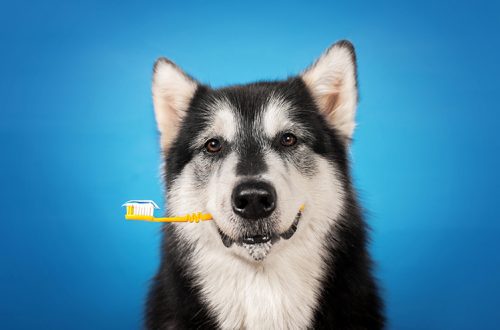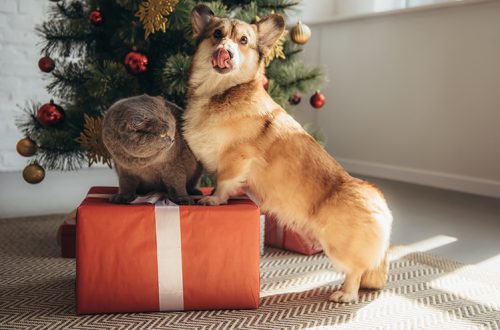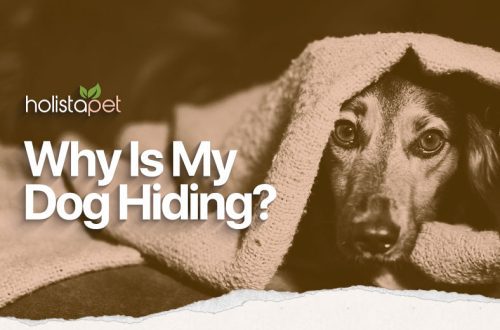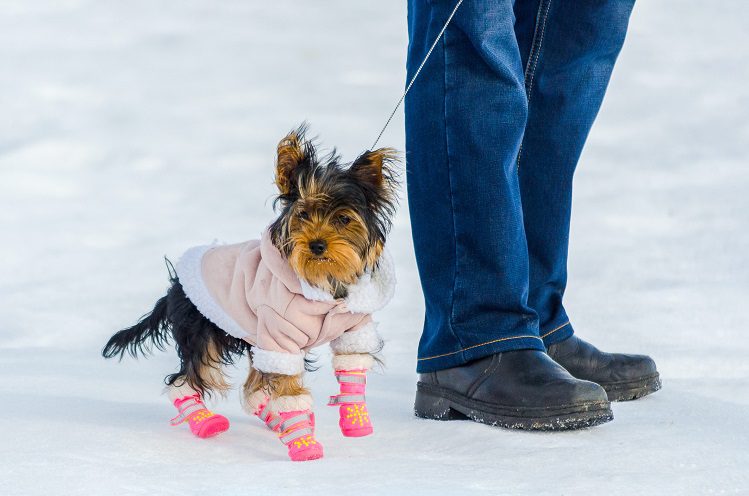
10 winter walks with your dog
In bitter cold, few people want to show their nose to the street. But active dogs cannot live without walking. Outside the house, four-legged comrades not only relieve their natural needs, but also warm up, spend the accumulated energy.
The question inevitably arises, and even several: how and how much to walk the dog in winter? How to make sure that she is not cold? What are the rules for winter walks? About everything in order.
Tips for walking your dog outside in winter
The coat and undercoat of most dogs protect them in temperatures down to about -10 degrees. If the street is -20 and below, then the four-legged will need the help of the owner. And some fragile dogs need warming even at a slight positive temperature.
To make both you and your wet-nosed pet comfortable, you should take into account certain nuances and take care of several things in advance.
- Consider the breed, age, mood and well-being of the dog
Can you walk your dog in winter? How much time to walk?
When it comes to walking in the cold, you should be sensitive and soberly evaluate your pet in all respects. For example, a large and active dog with thick hair can spend much more time in the cold than an average short-haired dog or a gentle “decorash”.
In severe frosts with small dogs it is better to stay at home – let them make puddles and heaps for a diaper for a day or two. A large dog should be taken outside in any weather, for the sake of a toilet and a short walk: 15-20 minutes near the house is enough. In some cases (if a pet with special needs, for example) you can limit yourself to one toilet.
The same applies to puppies and older dogs – you need to be very careful with them.
- Take care of your paws
Paw care in winter is especially important. Be sure to cut your pet’s claws and remove the hair between the fingers so that snow does not stick to it. The pads need to be treated with paw wax or a special cream so that they do not crack from reagents, cold and mechanical damage.
Better yet, buy shoes for your pet. And in the slush, and in the cold, such an accessory will be just the way for any breed.
It happens that the dog categorically does not perceive shoes and flatly refuses to wear them. Then a special wax will help you out, which is applied to the paw pads and creates a protective film.
Wash your paws after every walk, not only for the sake of cleanliness in the house, but also for the health of the dog (if he walks without shoes). Otherwise, while licking the paws, the dog may get poisoned with a road reagent. After washing, be sure to dry the paws, paying special attention to the areas between the toes, and apply a protective cream to the pads.
If the pads are left untreated, they will begin to crack, and each step will be given to the dog with pain. In addition, dirt and chemicals can get into the cracks, which will lead to inflammation.

- Choose the right clothes
How to keep your dog warm in winter? Of course with the help of special clothes! We have already said above that it is easier for long-haired dogs to endure cold than their short-haired counterparts. if you are forced to spend several hours on the street, then warm waterproof clothes will still be needed even for a healthy man, so as not to sting at all.
Owners of small breeds and dogs with short hair should definitely take care of warm clothing. Boots, a sweater, a hat, overalls – that’s the whole set for “frost”.
Yorkies, Chihuahuas, lapdogs, Pekingese, toy poodles and other similar dogs, do not forget to periodically take them in your arms so that they warm up a little and do not chill the genital area. Due to the proximity of this part of the body to the cold ground, short-legged dogs can get sick with cystitis.
- Don’t forget to be active
Let the dog run properly in the cold, it will warm it. Perfectly warms up the aport. To do this, throw a plate, ring, ball or regular stick away so that the wet nose has to run far. it is better not to throw it into deep snowdrifts, otherwise the dog will freeze ahead of time.
Don’t forget to go for runs with your pet. So you will reinforce his enthusiasm, and you yourself will warm up.
If the weather outside is not conducive to walking, then play with your pet at home, offer him a few toys, follow a few commands.
- Avoid dangerous places
In winter, both people and dogs are insidiously waiting for ice. Make sure that the dog does not run on ice, because. it threatens with dislocations, sprains and even fractures.
Also go around the construction site for a kilometer, because nails, glass, boards can lie there under the snow.
- Feed your dog before a walk
The dog’s winter diet should be a little different than the summer one: it needs to be made more nutritious and satisfying. Having eaten tightly, the dog will definitely want to spend the accumulated energy on the street.
- Don’t let your dog eat snow
It may seem to you that there is nothing like that – supposedly this is how the dog replenishes moisture reserves. But for these cases, responsible owners carry a bottle of warm water with them and offer it to the dog. A dog needs water in the winter just as much as in the summer. So that the water does not cool down on the street, you can pour it into a thermos or wrap the bottle in a towel and put it in a bag.
But snow can cause not only hypothermia, but also poisoning, because. it may contain chemicals and emissions from machinery. Even if you are walking in an ecologically clean area, snow is a poor alternative to water.
If the dog still strives to burst into a snowdrift, put on a muzzle.
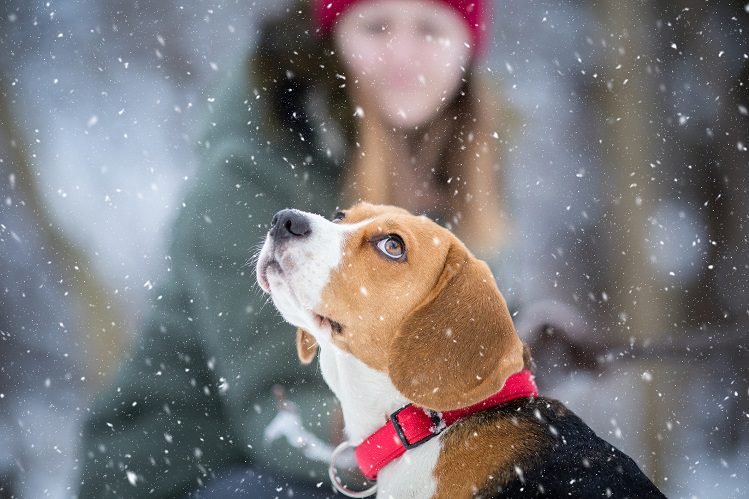
- Walk with a leash
In winter, the dog needs to be especially supervised. She can run and slip. And with a leash, the dog will not have much freedom. But what if the pet takes it into his head to rush into the melted pond for a stick? A leash will stop him from such an extreme idea.
- Follow the weather forecast
The weather forecast makes it easy to determine when it is best to go for a walk with your pet. Choose the time of day when it is warmest. As a rule, this is from noon to lunch. However, if you have a special regimen, then follow it, taking into account the recommendations.
- Watch the dog
The dog began to tighten its paws, tremble and look plaintively at you? Go home immediately. It doesn’t matter how much time has passed since you went outside. In severe cold, it is enough for dogs to leave the house only to cope with physiological needs.
A few more short tips
Be sure to take treats with you for a walk so that the doggie has a little refreshment;
Ears, paws and tail are the most vulnerable areas in dogs, so make sure that they do not freeze: feel every 5-10 minutes. If they are cold, it’s time to go home.
At the first sign of frostbite, take your pet home and wrap it in a blanket;
How to understand that a dog has frostbite: it breathes slowly, trembles, does not respond to external stimuli, the frostbitten part of the body is cold and hard to the touch, and when heat returns to it, it can become painful;
In no case do not rub the frostbitten area with snow or just with your hands, it will only get worse. It is important to keep your pet warm and calm and seek medical attention as soon as possible.
Call a specialist at home, because. going out and traveling will be another stress for the dog. Over the phone, the clinic staff will recommend first aid options for your dog before the arrival of the vet.
The mood, well-being and behavior of a four-legged friend is the best indicator that you should rely on in the first place. Want to jog in the park at -15 and ready for any adventure? Yes Easy! Shaking like a leaf in the wind and does not know where the day is at +2 degrees? March home and under the covers.
The article was written with the support of the Valta Zoobusiness Academy. Expert: Lyudmila Vashchenko — veterinarian, happy owner of Maine Coons, Sphynx and German Spitz.




